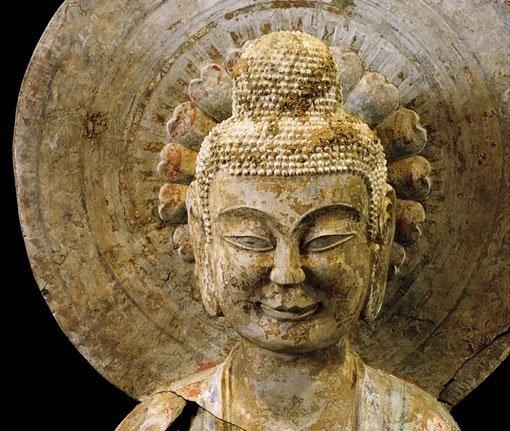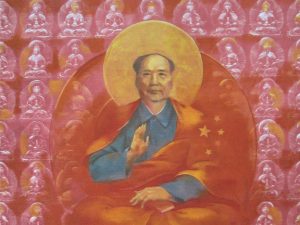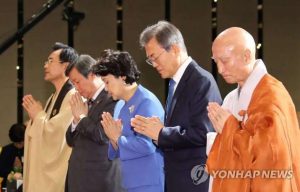
The Robert H. N. Ho Family Foundation Dissertation Fellowships in Buddhist Studies are a series of grants awarded to some of the most intriguing studies undertaken by research students about our Buddhist heritage. One recipient, Stephanie Lynn Balkwill, is preparing her thesis on nuns and empresses in the Northern Wei, a subject that has not fit neatly into the common perception of Chinese history as predominantly Confucian, male, and Han. Originally from Regina, Canada, Ms. Balkwill’s graduate studies were supervised by Dr. James Benn in the Department of Religious Studies at McMaster University, where she studied Buddhism and East Asian religion and culture from a historical and textual perspective. His careful and kind supervision allowed her to read Chinese, Japanese, and Sanskrit texts at the PhD level. At McMaster, she also took a PhD Diploma program in Gender Studies and Feminist Research, which is becoming an increasingly fruitful academic pathway for scholars of religion.
That Historical “Vacancy”
“There is a vacancy in history,” declares Headmaster Felix in The History Boys. “That’s very true,” agrees the new teacher Irwin, before realizing that he is being offered a job, not an observation. But what are the vacancies in Chinese history? Women have traditionally been excluded. When they weren’t, they served as simplified caricatures of political immorality (Wu Zetian and Cixi being prime examples). Buddhist nuns have also had little space for testimony. “My study seeks to bring to light the stories of a number of lesser-known individuals in Northern Wei history, and as such I have used a number of tomb inscriptions that provide biographies of female politicians and bhikshunis of the court of the Northern Wei,” says Ms. Balkwill. “Translating the tomb memorials of these women has been the most engaging part of my research so far. It has allowed me a glimpse into the lives that diverse kinds of women lead – a glimpse unavailable in sources such as dynastic histories and canonical Buddhist texts.”
“In 2012 I had the opportunity to spend a semester abroad as a student of Peking University, and I have been living in Beijing ever since, soaking up all the opportunities for historical study that China can offer – as well as sampling all the food,” she tells me. “I like a good story, and, to me, the best stories are the ones that you have to really dig into in order to appreciate their worth. This is, I suppose, what draws me to the study of ‘hidden faces’ in the history of China.” She nurtures deep enthusiasm for lesser-known chapters of the Chinese story. “In the study of China, the sources we have are so fantastic and diverse that we can find a vast number of these types of ‘hidden people’ just by digging through texts that are not normally read, and the stories of these people shed invaluable light on our understanding of their era’s social practices, norms and mores, and intellectual trends. I believe that the value of my work is precisely this focus on hidden faces and stories.”
Devout Empresses and Nuns
The Northern Wei could be called a vacancy in Chinese history. The dynasty was established in 386 CE by the Tuoba branch of the Xianbei people, an expressly non-Han ethnic group that only underwent sinification from the 430’s onward. Yet its part in consolidating Buddhism as a Chinese religion is incontestable and its women, according to Ms. Balkwill, are also understudied. “The women whose inscriptions I have translated were active in the court of the Northern Wei as it was then lead by two Empress Dowagers who were ruling behind child emperors at critical points in the dynasty: Empress Dowager Feng and Empress Dowager Hu,” she observes. “These two empress dowagers were incredibly influential not only for the shape of the dynasty but also for the growth of the tradition of Buddhism therein. Empress Wu Zetian may have overshadowed their stories, though I would argue that these Northern Wei women actually prefigured her reign. in putting these two Empress Dowagers back on the map, I discuss their works at length in my dissertation. I even offer a full translation of the official biography of Empress Dowager Feng.”
In order to express a language that can capture the gendered nature of her study, she coins the term “politics of patronage”. This is a specific term that refers to the synergy between powerful women of the imperial court, many who supported Buddhism ardently, and the nuns in their company (some of the imperial women were themselves bhikshunis). “This situation happened due to the historical circumstances of the Northern Wei wherein Northern Wei leaders often took women of other northern tribal groups as court ladies, wives, and concubines in order to cement tribal relations. As a result, the numbers of women in the inner court became quite large during the dynasty and required some form of internal organization,” says Ms. Balkwill. In response, the Northern Wei founded a complex bureaucracy exclusively for women, wherein their court ranks were more or less equal with the men’s. With such unusually high status, Northern Wei court women were empowered to support the rise of the bhikshuni sangha.
“They also joined the sangha at various points in their lives and funded the construction of fantastic nunneries,” Ms. Balkwill adds. “The few tomb inscriptions we have of Northern Wei bhikshunis offer some clues as to why the women of the court did this, and those clues suggest that the sangha worked alongside the inner court to ensure the safety, longevity, and social prestige of court women when court intrigues would have otherwise sent them away from their high positions.”

The Borders of Knowledge
A general, easier-to-find “politics of patronage” can be found in the building of the Yungang caves outside Datong, wherein court and sangha worked together for mutual benefit and prestige. But, Headmaster Felix’s vacancy in history is not discovered in the Yungang caves. It is reclaimed in the social and physical ‘borders’ of the Chinese imperial center. “I’m interested in the precise ways in which various peoples have interacted with the Chinese imperial center at various points in history,” says Ms. Balkwill. “Originally, this interest manifested itself in the study of Chinese women, as women have had a different relationship with empire than men have had due to traditional forms of gender organization. However, over the years I have deepened my understanding of these ‘borders’ and have now come to be fascinated by the historical relations between traditional Han Chinese culture and the number of non-Chinese groups that it has come in contact with. The historical, political, religious, and physical places of contact between the Chinese empire and various non-Chinese groups provide endless opportunities for engaging historical research.”
I ask Ms. Balkwill about her future plans. She hopes to undertake two research projects in the future: the first is an investigation into how the Buddhist ideal of female-to-male sex change for the cause of Buddhahood was understood in varying temporal and geographical places across Asia. The second is a detailed study of the roles that the northern dynasties played in the spread of Buddhism to Korea and Japan. “I believe that both of these projects will allow me to tell stories of real historical merit – stories that will help work toward a better understanding of some of the questions that still vex us in the modern day, namely the questions of the status of women in Buddhism and the shape of the East Asian tradition,” she says. “I’m looking forward to teaching one day and my dream teaching roster would include courses on women’s lives in Chinese religious history, Chinese religion in the Six Dynasties, Buddhism and empire, and the Buddhism of the northern dynasties, as well as a more formative research class on reading Chinese epigraphs.”
Recovering Lost Stories
But for now, she has a more urgent tale to tell. “A study of women, Buddhism, and the non-Chinese conquest dynasty of the Northern Wei provides an excellent opportunity to explore how each of these factors came in contact with the Chinese empire, and in fact, how all three of them changed not only China but also each other in specific ways that can be traced through the historical record. In tracing out such a history, it is my hope that my research is of value to modern practitioners of the Buddhist tradition who seek to understand the history of Buddhism so as to contextualize their own practice therein.” The project, as it is with many other academics, is all about building historical awareness for our present and future generations. “My dissertation is itself a story – the story of a brief moment wherein a non-Chinese dynasty successfully undertook ambitious projects of sinification and Buddhist diffusion, wherein women were major players, thus forever changing gender politics, the form of later Chinese society, and the practice of Chinese Buddhism. It sounds a farfetched story, but it is there, often inscribed in rocks, just waiting for us to uncover.”












